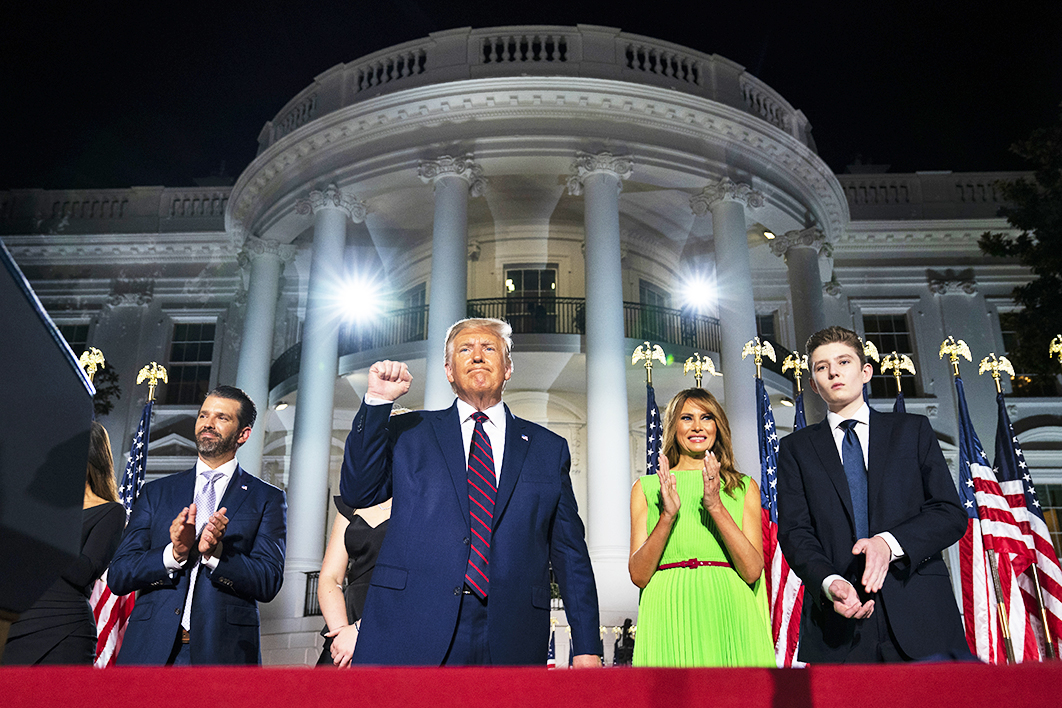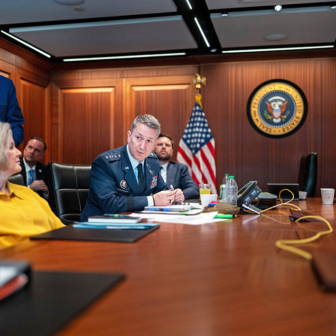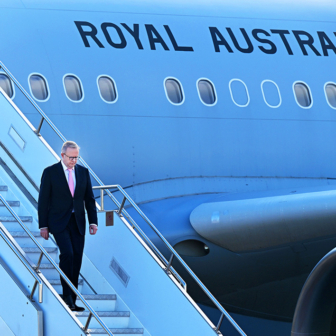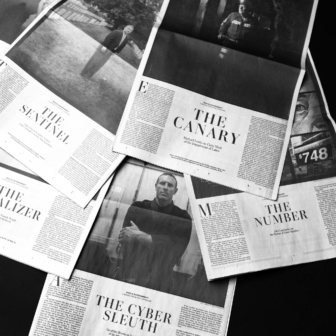The first night of the Republican National Convention featured the most important speakers of the week: Mark and Patricia McCloskey. Other speakers may have been more famous or persuasive, but it was the McCloskeys, attorneys from St Louis, Missouri, who embodied the campaign’s central message for 2020: white Americans are in danger, and only Donald Trump is on their side.
The McCloskeys entered the spotlight in late June when they stood outside their suburban mansion and brandished guns at anti-racist protesters passing by their house. Aside from the armed homeowners themselves, there was no conflict and no intimation of violence, just a protest weaving its way through the neighbourhood. But in their convention appearance, the McCloskeys told a quite different story.
Mark described himself and his wife as simply “defending our home,” while Patricia warned, “What you saw happen to us could just as easily happen to any of you who are watching from quiet neighbourhoods around our country.” And it wasn’t just protesters threatening suburban homes. Democrats, Patricia claimed, “want to abolish the suburbs altogether,” inviting “crime, lawlessness, and low-quality apartments” into suburban neighbourhoods.
“So make no mistake,” she said. “No matter where you live, your family will not be safe in the radical Democrats’ America.”
The McCloskeys appeared at the convention as avatars of both white flight and “law and order” politics. They represented a decades-old argument: that the suburbs are under attack from the chaos of the cities, chaos allowed to thrive because Democrats coddle criminals and punish police. And all of those ideas — suburbs and cities, quiet and chaos, police and criminals — are deeply racialised, coded as white and black even when race is never mentioned.
In the days that followed, Republicans at the convention returned again and again to the idea that America was on the verge of collapse, rent by rioting and lawlessness, and that only Donald Trump could put things right again.
It’s an unusual argument for an incumbent, calling attention to the fact that, despite already being president, he has neither prevented nor stopped the perceived lawlessness happening on his watch. Yet this idea has now emerged as the central theme of the Republican campaign, the one everything from television ads to the president’s Twitter account will revolve around in the coming months.
So it’s important to understand what it is, and what it isn’t. The shorthand for this kind of campaign is “law and order,” but that’s just branding. After all, the rule of law has been an obstacle not an ally for the Trump administration. This is true for the McCloskeys as well: they have been charged with unlawful use of a gun for brandishing their weapons at peaceful protesters (though Missouri’s governor, in a very Trumpian move, has vowed to pardon them if they are convicted — laws for thee, not for me).
Nor is the Trump campaign particularly interested in instituting order. Trump has long pitched himself as the chaos candidate, the person who can shake things up and burn things down. In the past several months, as the pandemic, protests and police riots have upended life in the United States, he has continued to be a chaotic force, promoting miracle cures and misinformation about Covid-19 treatments, and unleashing federal law enforcement on peaceful protesters outside the White House.
In fact, his administration has made clear that they believe the chaos is good for them. Trump adviser Kellyanne Conway said during the convention that “the more chaos and anarchy and vandalism and violence reigns, the better it is” for the president and his brand as the law-and-order candidate.
Whether that’s true is not entirely clear. After all, Trump used a very similar approach in the 2018 midterm elections, when he went all-in on the so-called “migrant caravans” that, he warned, would lead to an invasion of the United States. “The Democrats don’t care what their extremist immigration agenda will do to your neighbourhoods or your hospitals or your schools,” he said at a rally in Houston two weeks before the elections.
For weeks Trump had tweeted and talked about the caravans, hoping to provoke a sense of fear and anxiety that would draw white suburban women to the Republican Party. It didn’t work. The election was an overwhelming triumph for the Democrats.
So why is Trump going back to that well? In part, because he still believes it’s how you win suburban white women, who have been a key voting demographic since the days of the “soccer mom” back in the 1990s. Those women were the focus of the Republican convention, and the target of the party’s “defend your homes!” campaign.
But there’s reason to believe it might not work. Women, particularly college-educated women, have fled the Republican Party over the past four years, with 51 per cent opting for Hillary Clinton in 2016 and now 59 per cent supporting Joe Biden. The party has also started losing the suburbs, something 2018 crystallised for political observers. Before that year’s election, the GOP controlled sixty-nine suburban districts; after, it controlled only thirty-two.
Trump still has a June Cleaver view of suburbs, which is why he keeps tweeting about the “Suburban Housewives of America.” But not only has that idea of women’s place long since passed, the suburbs themselves have also changed, becoming more diverse in terms of race and class. Winning the suburbs means appealing to more than just middle-class white families.
The other reason Trump is rolling out a save-our-suburbs campaign is that it’s the only kind of campaign he knows. Race-baiting — and that’s what this is, not “law and order” or “family values” — has been a staple of Trump’s politics since the day he entered the race in 2015 railing against Mexicans as “rapists and murderers.” The backbone of his 2016 campaign was policies like the border wall and the Muslim ban; we shouldn’t be surprised that in 2020, barely coded racist appeals would be the core of his campaign.
Even if this appeal doesn’t work, it’s already having other consequences. The call to defend the suburbs has helped rally militia groups, who have been especially active this year. Last week, a seventeen-year-old named Kyle Rittenhouse, who appears to have travelled to Kenosha, Wisconsin, in connection with militia groups, shot and killed two people involved in protests there. The president has refused to condemn his actions, and Rittenhouse is quickly becoming a hero of the right. Which means more chaos and violence are likely to follow.
The election, then, will be a referendum on all this unrest, around both policing and the pandemic. For Democrats, it’s a matter of reframing the president’s claims that people won’t be safe in Joe Biden’s America — pointing out, for instance, that all the chaos happening now is happening under Trump’s watch. But fear is a powerful political force, and Trump will be leveraging it as much as he can in the coming months, hoping to convince white Americans that he is their best hope for the future. •




